
Last year I invested in a standing desk and built my own treadmill desk. But I’ll admit, it took some time to get into the swing of using my new desks.
Only recently something has shifted. My total sitting time has dramatically plummeted. Standing time has sky rocketed. Movement is now the new norm.
What helped to make the shift from sitting to standing to walking?
I put it down to two things:
1) Perseverance (forcing myself to stand even when it felt strange); and
2) Being reminded of the health benefits of standing and walking (rather than sitting).
1. Perseverance
I’ll admit, using my standing and treadmill desks felt strange at first. My legs would get tired. Sitting felt a lot easier than standing.
No one ever told me that this was going to be challenging to begin with. That it would initially feel awkward. So I found myself sitting for most of the day with the occasional 20 minute burst of standing thrown in. Sure, it was better than nothing but it was still far from ideal.
What made all the difference in terms of getting my butt out of the chair? A bit of good old-fashioned nagging and an electronic timer.
Basically, I needed to be reminded to get out of my chair and stand. My brother would say, “Why aren’t you standing Jane? Get up!” I would think, “Yeah yeah…” and begrudgingly pull the handles on my desk to move into standing position.
When my brother wasn’t around, I’d set a timer to remind myself when I needed to stand. Outsourcing my standing time freed me up to focus on other things.
Over time, standing started to feel more natural and comfortable. And as for sitting? The tables have turned. Now sitting feels awkward. When I sit I feel sluggish and less alert.
2. Understanding the benefits of sit-stand desks and treadmill desks
The research is in: sitting for long periods of time reduces your lifespan. It also increases your chance of getting type 2 diabetes, cardiovascular disease, some cancers and becoming obese.
“But I go to the gym/work/ride my bike every day!” I hear you say. I used to tell myself the same thing. But you know what? It doesn’t matter. One hour of exercise can’t counteract 8-hours of butt in chair. You’re still in the danger zone (cue dramatic music).
To improve your chances of living a healthy, long life, you need to focus on two things:
1) Reducing your overall sitting time; and
2) Breaking up periods of sitting with standing.
So we know that sitting sucks. But what does the research say about the benefits of standing?
Studies have found people who use standing desks experience less physical pain, feel more productive, are less fatigued, and more alert.
In addition, people who stand burn more calories a day than people who sit. One study found that standing while working during weekdays for a year burns the same amount of calories as running 10 marathons.
Do you like the sound of running 10 marathons on work time without actually running 10 marathons? Then get your comfy shoes on, grab that cushioned floor mat and start standing.
Still not convinced? Check out Dr Michael Greger’s video, ‘Standing up for your health’.
Other tips for using your standing desk
To get the most out of your standing desk and ensure you go the distance with your standing desk, consider doing the following:
Use a soft floor mat
This helps take the pressure off your feet and legs.
Don’t be like a statue
Engage in small movements whenever you can (e.g., do some calf raises, shoulders rolls, shake your legs, walk around a bit).
Mix it up
Don’t force yourself to stand all day. For instance, why not stand for 30 minutes and then sit for 30 minutes? See what feels best for you. Only you can figure out your stand to sit ratio.
Get your posture right
When I first started using my standing desk, I had a bad habit of leaning to one side and putting all my weight on one leg. I started to experience pain in my knees (thankfully, once I corrected my posture the pain disappeared).
When working at your desk, your feet should be shoulder width apart. Your knees should be straight but not locked.
Wear comfortable shoes
There’s nothing worse than standing for hours on end in uncomfortable shoes. Invest in a pair of flat shoes or opt for no shoes (on a soft mat).
To sum up
Remember, the more you stand, the easier it gets! When you feel like giving up, see if you can challenge yourself to keep standing for a little bit longer. Because what the sit-stand desks manufacturers don’t tell you is that working in this way takes practice.
But if you keep at it, the benefits will be well worth it.
Have you ever used (or currently use) a sit-stand desk? Or perhaps you have a treadmill desk? Do you have any tips to share on how you use your desk? I’d love to hear from you! Feel free to post a comment below.
Share This:
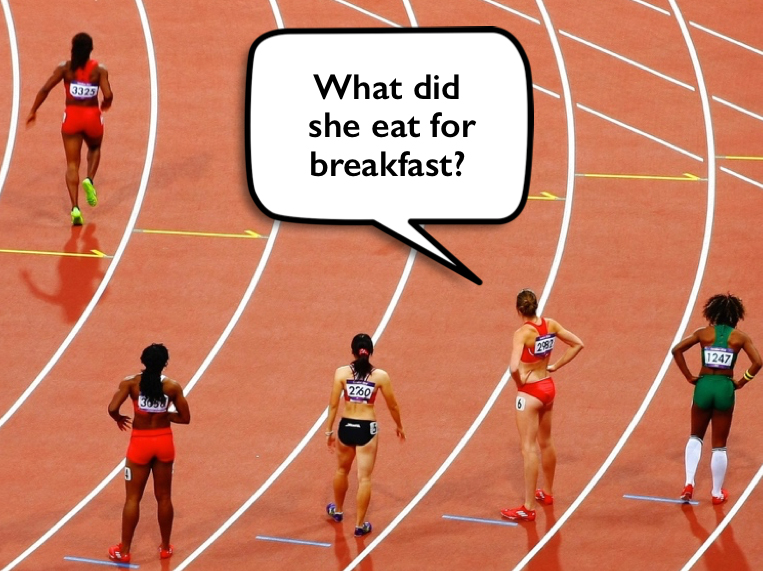
This means you need to prepare yourself mentally and physically for them.
You can work so hard to memorise large quantities of information for an exam, but if you’re not mentally and physically prepared, all that hard work can sadly go to waste.
When it comes time to take your exams, you have to relate to yourself as a professional athlete. Leading up to the day of the big performance (i.e. the exam), you need to eat nutritious food, be in the right frame of mind, manage your nerves, and allow your body to rest. These simple things can make all the difference to your exam performance.
You may be thinking “But isn’t this just common sense?”
It is! But creating healthy habits takes time and practice.
It’s one thing to intellectually know you should be eating well but it’s another thing altogether to incorporate healthy meals and snacks into your lifestyle.
I see a lot of students drinking energy drinks, getting very little sleep, and eating highly processed foods in the days leading up to exams. I have to admit, there was a time when I engaged in these behaviours too. I can tell you from personal experience, this is a recipe for mediocre grades and a miserable existence.
Here are my top 10 tips to prevent burnout and boost exam performance:
Sleep is critical to the learning process, exam performance, and wellbeing. Yet it’s usually the first thing students sacrifice to get more study done.
If you miss two hours of sleep each night for a week, the cognitive effects are as bad as going without sleep for two days straight!
Studies have also found that if you stay awake for 18 hours straight that’s like having a blood alcohol level of 0.05. In other words, it’s like being legally drunk. Your ability to focus, think, and learn will be seriously impaired.
You can’t adapt to getting less sleep. As adolescents, you need about 9-10 hours of sleep per night to be as alert as possible when you wake up.
If that feels unachievable, try to just get an extra 15 minutes of sleep tonight. Gradually increase this each night until you reach your target.
Often students stop exercising when they start preparing for exams. They think “I don’t have time to exercise!”. It’s as if they think they must spend every moment studying. Don’t fall into this trap.
Movement is your friend when it comes to studying for exams.
Research shows engaging in regular physical movement will help you to study more effectively. Firstly, it’s a great way to relieve stress and release feel good chemicals. Secondly, it gets the blood flowing more efficiently to your brain, which can give you a cognitive boost.
One study found students who engaged in 5 minute movement breaks every 17 minutes during a lecture retained more information and could focus better.
Every time you engage in a short movement break, you’re enhancing your study sessions.
Research has found that students who skip breakfast experience a decrease in cognitive performance and alertness compared to students who eat breakfast.
Eating a nutritious breakfast will give you a cognitive boost before an exam. It will also help you to feel fuller for longer, stabilise your mood, and give you plenty of energy to get through the exam.
Here are some healthy breakfast ideas:
Muesli or porridge with nuts and fresh fruit (e.g., berries) Wholemeal toast with a variety of toppings (e.g., baked beans, tomatoes, and avocado) and a piece of fruit A healthy homemade smoothie (click here for my brain boosting smoothie recipe)
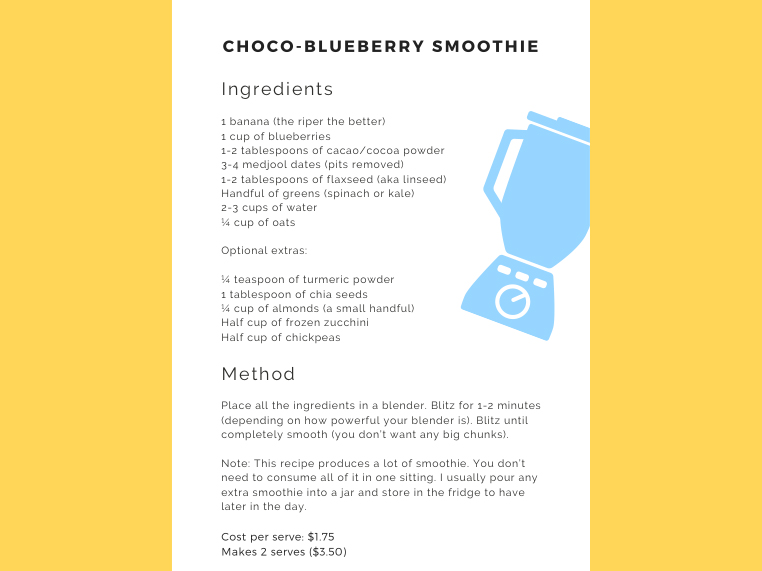
Your brain requires adequate hydration to function properly. Drinking water ensures that your brain receives the necessary fluids to perform tasks efficiently, such as retaining information and problem-solving.
Take regular sips of water as you study. It’s a good idea to have a glass of water or a reusable drink bottle within arms reach.
You may even want to create a tiny habit to remind yourself to engage in this simple behaviour (e.g., “After I finish answering a practice exam question, I will take a sip of water”).
Many years ago, I started thinking that my teachers and lecturers were out to get me. I thought they would mark me down wherever they got the chance. As a result of this distorted thinking, I became too scared to write anything in one of my first tests at law school. After receiving a terrible grade (5%), my brother said to me:
“Remember sis, your teachers want you to do well. They will try to give you marks wherever they can. It’s in their best interest to do so.”
Don’t worry about writing a perfect answer. If you’re unsure, be brave and still write something down. Even if it’s just a few dot points, it’s better than nothing. You may not get any marks for it, but your teachers won’t take marks off.
Just remember, most of the time your teachers are on your side and they want you to succeed. When you do well, it makes them look good.
Chances are there will always be something that you could have studied more thoroughly come the day of your exam. But on the morning of an exam, you can’t do much about that, so there’s no point worrying. Worrying will just deplete your finite energy, which you need to conserve for the exam.
Instead of worrying, try saying this to yourself before each exam:
“I now know so much more than I did before. I’ll be able to answer many questions in this exam.”
Telling yourself this positive micro-thought will allow you to enter the exam in a calm and confident frame of mind.
It’s normal to feel a bit nervous before an exam. But there are certain things and people that can push your anxiety levels into dangerous territory and impair your exam performance.
For example, coffee and energy drinks will skyrocket your stress levels. Similarly, hanging out with people who have a lot of nervous energy and are venting about the exam (“I’m going to fail!” and “I hardly studied!”) are going to leave you feeling distracted and a little jangled.
Before the exam, do your best to isolate yourself from these people. If you’re worried about offending someone who is venting to you, you could say “I’m sorry but I really need to do some last minute cramming”. Then proceed to pull out your notes and pretend to read them.
How many times have you stayed back after an exam to talk to your friends about what you put for each question? Have you ever felt terrible after doing this?
It can be reassuring to know that you wrote the same answer as your friends. But if you find out that you wrote something completely different, you may start to second guess yourself. If you have another four or five exams to go, this may throw you off your game.
This is why I don’t recommend engaging in a postmortem of the exam until you get your results/exam paper back.
When you walk out of the exam room, tell yourself:
“That exam is over. There’s nothing I can do to change how I went. It’s time to move on!”.
You could imagine yourself locking the exam in a box and throwing it off a cliff or rolling it up and stuffing it in a bottle and throwing it out to sea. The point is you need to mentally disconnect from that exam and focus on studying for the next one.

If you come across a question that you’re not sure how to answer, stop for a moment and take a few deep breaths (in for the count of 4 and out for the count of 4).
A simple breath activity you can try is the Box Breathing Technique. This involves imagining yourself breathing along the sides of a box (breathing in for the count of four on one side, out for the count of four on the next side, etc). Repeat this 2-3 times. Then take a look at the question again.
If you are still unsure how to answer the question, move on to another question.
The worst thing you can do is panic (remember, stress impairs your ability to think and recall information).
By engaging in Box Breathing, you can help yourself to remain in a calm and stable state.
Many of us are familiar with writer’s cramp. This can be caused by gripping onto your pen too tightly. Try loosening your grip a little.
Alternatively, experiment with a range of different pens. Some biros require you to press down hard on the page to make a mark, but not gel pens. The ink just flows onto the page!
The reality is, even with a good gel pen, your elbow will start to hurt at some point if you’re taking a 3 hour exam. When it does start to hurt, have a rest for a few seconds (yes, you have time to do this). Stretch your arm out. Shake it a little.
Treat each exam like a mountain hike rather than a 100 metre sprint. Resting for a few moments here and there will be time well spent and will enhance your overall performance.
These simple strategies can help to elevate your exam performance. My advice is to start small. Even if your exams are several weeks away, select one or two of these ideas and start testing them out today. At first, the strategies will require a bit of mental effort. But like anything in life, if you persevere they’ll become second nature to you and they’ll just be things you do without even thinking.
Want to learn more exam strategies? Click here to download a free copy of 70 ways to ace your exams.
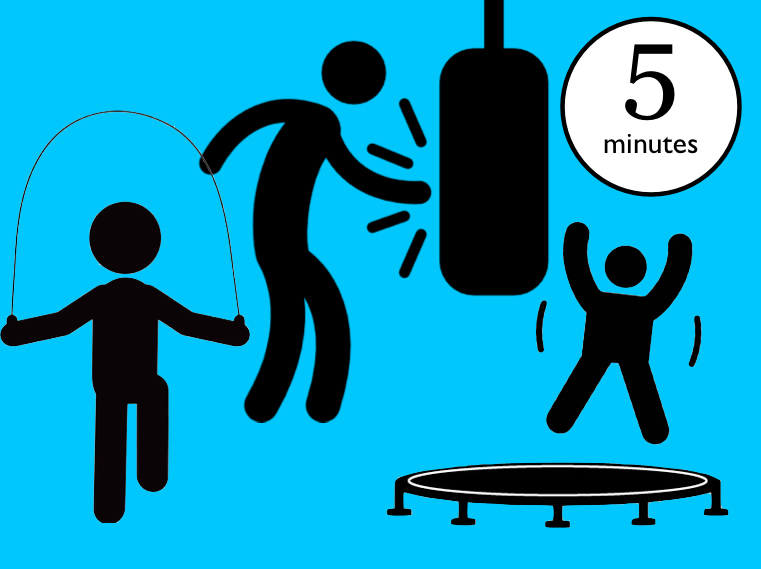
Here’s a simple thing you can do to help you focus better and improve your study sessions . . .
Take regular exercise breaks.
A study titled Sweat so you don’t forget found that engaging in regular five minute exercise breaks reduced mind wandering, improved focus, and enhanced learning.
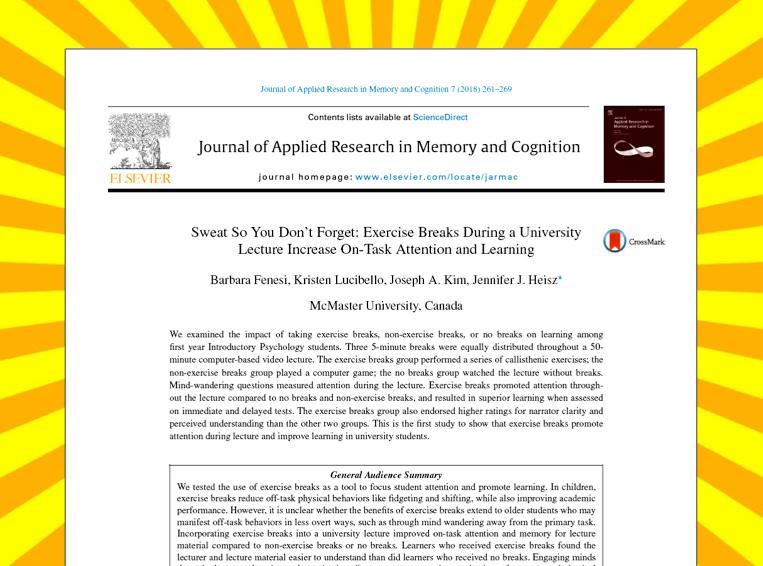
In this study the researchers wanted to know if engaging in short exercise breaks could help with learning.
They took a group of 75 psychology students and split them into three groups.
Group 1: Exercise breaks group
Group 2: Non-exercise breaks group
Group 3: No breaks group

All the students had to watch the same 50 minute psychology lecture. But the difference between the groups was this . . .
The exercise breaks group performed five minutes of exercise every 17 minutes. The non-exercise breaks group played a simple video game for five minutes every 17 minutes. The no breaks group had to watch the entire lecture without getting a single break.
The students in the exercise breaks group could focus better and they retained more information. They also found the lecturer easier to understand.
The researchers said:
“The exercise breaks buffered against declines in attention resulting in superior engagement during the latter part of the lecture compared to the other two groups.”
One would think they would show some improvements in attention and memory since they were getting breaks. But they didn’t show any significant improvements.
In fact, they performed just as well as the no breaks group in terms of attention and memory.
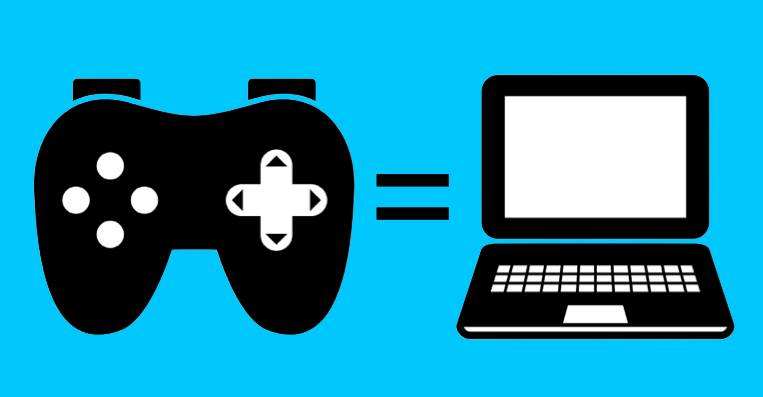
The researchers concluded:
“One possibility is that the computer game played during the non-exercise break may have acted as a second cognitive task as opposed to a cognitive break. Switching between two cognitive tasks can deplete attention and impair performance for both tasks.”
This shows the type of activity you engage in on a study break is really important. It pays to get out of your head and move your body!
It was a series of exercises performed for 50 seconds each followed by a rest break:
1) Jumping jacks (50 seconds) + Rest (10 seconds)
2) Heeltaps (50 seconds) + Rest (10 seconds)
3) High knees (50 seconds) + Rest (10 seconds)
4) Split jumps (50 seconds) + Rest (10 seconds)
5) Hamstring kickers (50 seconds) = The End
Since reading this study, I’ve started to incorporate more exercise breaks into my day and I’m noticing a big difference.
Personally, I’m not a fan of some of the exercises the researchers made the participants do in this study. So, I have replaced them with other cardio exercises I enjoy doing, such as punching a boxing bag and using a skipping rope.
I also find doing 50 seconds of non stop exercise pretty exhausting. For this reason, I’ve reduced my exercise time down to 40 seconds followed by a 20 second rest break. I find it helps to time my exercise sprints/rest breaks using an interval timer on my phone instead of a kitchen timer (which can feel a little clunky).
Feel free to experiment with different exercise/rest ratios. Make it work for you. As your fitness levels improve, you can increase the period of time you exercise for.
After working for 20 or 30 minutes, get up and take a five minute exercise break.
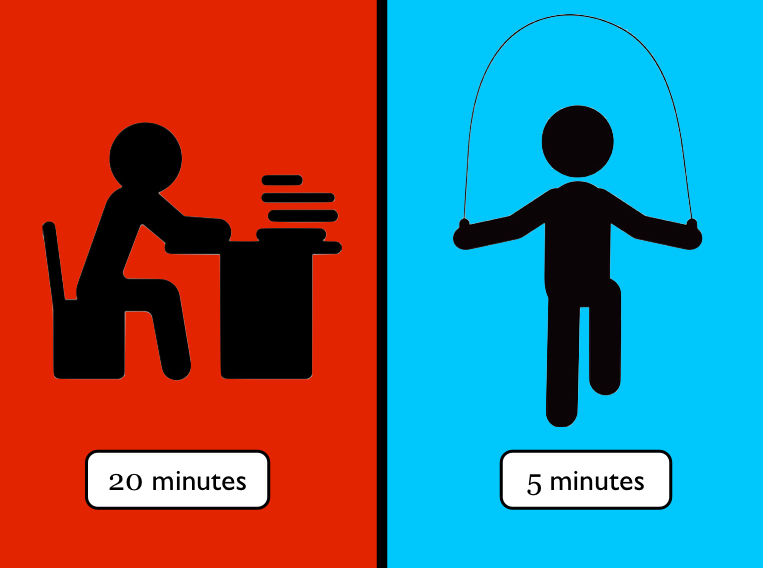
You don’t have to do jumping jacks or hamstring kickers. Select simple exercises you want to do.
Notice how you feel before and after your exercise break.
After experimenting with this simple strategy, I can say with confidence that I feel more energised and mentally sharper throughout the day. Try it and let me know how you go!
I force myself to do this because by the end, I feel amazingly good.
Exercise gives me a natural high.
Comedian and writer Catherine Deveny says:
“[After exercise] My body feels better, my mind clearer, my heart lighter and I’m happier and less grumpy. Starting the day with some cardio makes me move faster for the rest of the day; I end up getting more done.”
Oh, how I can relate!
These benefits have helped me to conquer my inner couch potato and create healthy habits.
99% of my workouts leave me feeling great. But a couple of months ago, I did a workout that messed with my mind. By the end, there was no natural high. I just felt bad.
Here’s what happened . . .
My alarm went off in the morning
That was my cue to get up and get moving.
After a busy weekend, I felt exhausted. Did I want to exercise? No way.
But I managed to drag myself out of bed, get dressed and drive to the gym. I reminded myself, “After the workout, you’ll feel good.”
I arrived at the gym and started jogging with everyone else.
I was huffing and puffing. It felt hard but I was there. I was doing it.
I said to myself, “Good work Jane. Keep going.”
Then we started doing push ups.
I thought, “This mustn’t look pretty but I’m here. I’m doing it. And showing up is what matters.”
I was starting to get into the groove of the workout. I was feeling less groggy and more mentally alert. The feel good chemicals were beginning to kick in . . .
But then the instructor said something that threw me off track. It was a simple comment but it derailed me. Here’s what she said:
“You’re really struggling today Jane. You look really tired.”
All of a sudden, everything felt ten times harder. And I felt really tired.
My mind was spinning out of control with thoughts like . . .
“I must look really tired and stupid doing these exercises. Why didn’t I just stay in bed?”
“I have to go and present at a school shortly . . . will I be able to do it?”
“Maybe I’m not up to it today? Maybe my talks will be a flop?”
No matter how hard I tried, I couldn’t stop the negative self talk. It was relentless.
As I was driving home, I noticed I felt upset. I found myself thinking, “Did the gym instructor have to make those comments?”
Her comments weren’t helpful. They weren’t motivating. They just made me feel lousy and clumsy.
Was I being overly sensitive? Perhaps.
But I knew this was one of those moments where I could easily throw in the towel. It was a make or break moment.
A few days later, I had a realisation . . .
These things are hard work. They’re tiring. They can cause us discomfort.
But it’s the discomfort and strain that often leads to progress.
I think this is where some of us go wrong in life – we expect things to be easy.
As soon as things become slightly challenging, stressful or a strain, what do we do?
We give up.
We take the easy and more entertaining path. We escape to our devices for instant gratification.
As best selling author Mark Manson says:
“Our tolerance for pain, as a culture, is diminishing rapidly.”
Modern life has deluded us into thinking the easy way is the best way forward. But I’m not so sure it is.
I think if you can resist instant gratification and stick at something that is challenging, you’ll be better off in life (certainly in the long run).
The other thing I like about working out and lifting weights is it builds my tolerance for discomfort and stamina to complete big projects.
For instance, I recently started participating in boxing classes. There is nothing easy about boxing. Each class is a hard slog.
But my boxing teacher is super motivating. She has this saying:
“Without pain, there’s no progress!”
I asked her what exactly she meant by this. Surely, if my knee hurts, I shouldn’t keep kicking the bag?
She explained . . .
“I’m not talking about pain in a specific area. It’s about experiencing the feeling of challenging your body. Pushing past your limit because that’s where the magic happens.”
She added:
“Some days are going to be harder than others, but that’s okay!”
It may feel counterintuitive but avoiding stress and pain isn’t good for us. It actually has the opposite effect. It makes us weak. As Mark Manson says:
“. . . if you avoid stress and pain (i.e. you sit on your damn couch all day watching Netflix) your muscles will atrophy, your bones will become brittle, and you will degenerate into weakness.”
So whatever challenge you’re facing in your life right now, don’t avoid it.
When you feel the discomfort, nothing is wrong. Take it as a sign that you’re on the right path. Keep going. Challenge yourself to take the next step. Because that’s where the magic happens.
Dr Jane Genovese delivers interactive sessions on learning to learn, combating procrastination, exam preparation, how to focus in the age of distraction, habit formation and much, much more!
Get FREE study and life strategies by signing up to our newsletter:
© 2024 Learning Fundamentals